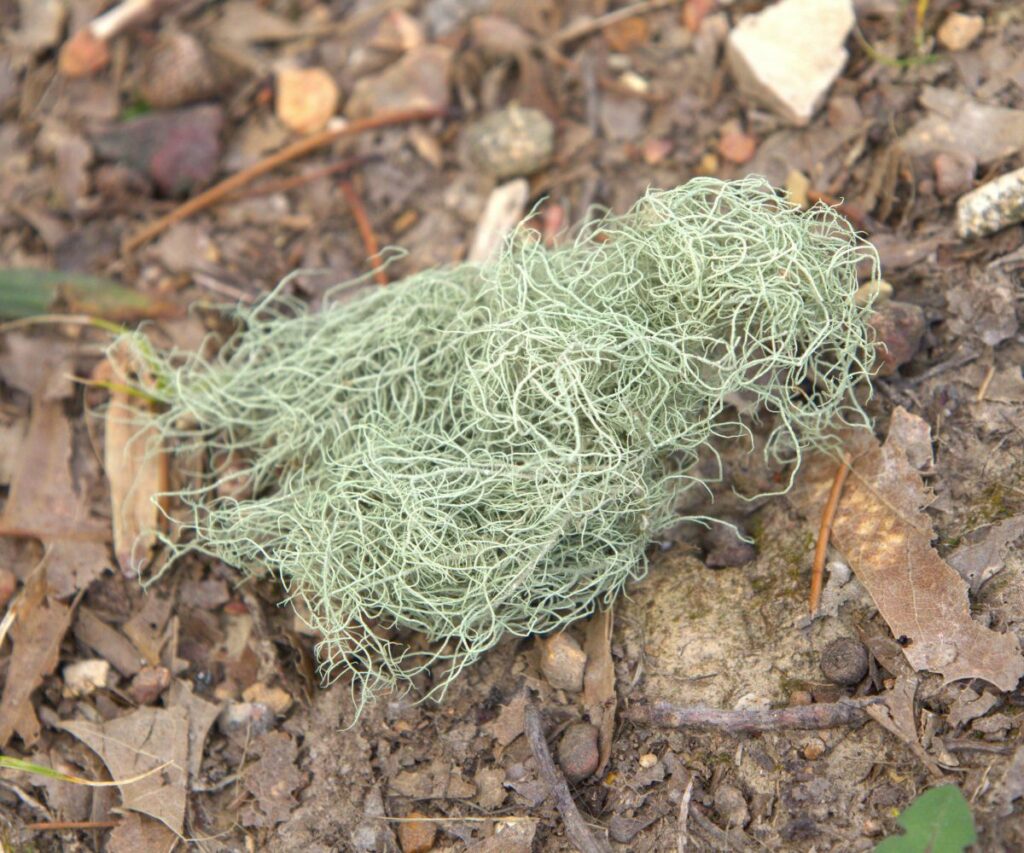

People have been using usnea for thousands of years.
This lichen can serve many applications because of its unique, multifaceted chemical composition. It’s a common functional ingredient in cosmetics, cleaners, medicines, and more.
So, what exactly can you do with it? Read on to discover 15 science-backed usnea benefits and learn how to harness its power to improve your home and health.
Usnea Uses and Benefits
Usnea is a true unicorn in the world of natural remedies.
All species contain the namesake usnic acid, a much-studied substance that gives this lichen impressive antiseptic abilities. However, usnea is much more than a natural germ-fighter.
Thanks to its various polyphenols and acidic profile, it wears an array of additional health and wellness hats that increase its value tenfold.
1. Antibiotic
One of usnea’s oldest applications is as an antibiotic. Modern clinical research supports this historical use, with usnic acid being particularly effective against gram-positive bacteria, such as strep and staph.
Usnea and its derivative drugs have shown promise in treating even antibiotic-resistant strains of these bacteria.
The best way to use usnea as an antibiotic depends on the infection’s location. A tincture is best for internal infections (think urinary tract, kidneys, etc.), while an ointment or salve will treat external skin infections.
Usnea is also known to help clear lung infections, making an excellent addition to homemade cough syrup or fire cider.
2. Anti-Inflammatory
It seems like everything is inflamed these days, but usnea can help by targeting inflammation from a multitude of underlying causes.
From intestinal discomfort to muscle pain and joint swelling, this lichen has you covered.
It’s best to use a variety of preparations, including tinctures, salves, oil extracts, and usnea powders, to treat inflammation depending on where it is and what’s causing it.
3. Analgesic
Usnea is a potent analgesic, with one study demonstrating pain-relieving effects similar to the once-common NSAID drug noraminophenazone.
Internal application can help soothe sore throats and ulcers and may be better than other meds considering usnea’s powerful effects against inflammation.
It’s also the perfect ingredient for external pain treatments, such as DIY muscle balms and joint salves.
4. Wound Healing
Usnea has long been used in wilderness first aid as a topical to treat scrapes, bites, and other wounds.
Not only does usnic acid prevent and treat infection, but research shows it also speeds up healing when applied as a powder or poultice.
The usnic acid actually promotes vascular regeneration and skin keratinization, enhancing the formation of healthy new collagen tissue at the site of wounds.
5. Promotes Skin Health
Usnic acid is a skin savior. Its antimicrobial and antiseptic properties help cleanse the skin and eradicate bacteria, while anti-inflammatory and antioxidant effects reduce stress to combat wrinkles and spots.
Usnea has also been shown to protect against UV rays and shows particular promise as a sunscreen and in other cosmetic applications.
Using an usnea oil extract to make salves or balms is the best way to get these effects.
6. Fights Cancer
Usnic acid is a proven cytotoxin that can fight certain types of cancer cells.
Research trials on humans with mouth cancer showed usnea extract increased oxidative stress and blocked DNA synthesis in CLS-354 cancer cells, resulting in a significant anticancer effect.
Animal research studies indicate effectiveness against melanoma and glioma.
Interestingly, the research demonstrates usnea’s ability to distinguish and attack cancer cells while protecting healthy tissue.
Tinctures made with dual extractions of water and alcohol will yield the highest content of polyphenols and usnic acid, which are both thought to contribute to this effect.
7. Aids Weight Loss
I’m as skeptical as the next gal when it comes to miracle weight loss drugs. And while usnea certainly isn’t a magic cure, there is compelling evidence showing usnic acid may help improve lipid metabolism.
In animal trials, it has been shown to slow weight gain on a hypercaloric diet, reduce triglycerides, and improve cholesterol levels.
Adding a modest regimen of dual-extracted usnea tincture to your diet could make the weight-loss grind a little easier!
8. Protects Heart Health
Usnea’s ability to regulate cholesterol and triglycerides already makes it a potent heart health weapon in your arsenal.
It has also been proven to reduce atherosclerosis, or hardening of the arteries, especially around the heart’s aorta.
Usnea can even prevent blood clots that lead to heart attacks, strokes, and other dire cardiovascular events. If you are currently at risk, ask your doctor about supplementing with usnea until you get the issue under control.
9. Anti-Fungal
Usnea is an effective treatment against many species of yeast and fungi, rendering it a potent aid for candida infections and many types of ringworm.
Apply usnea oil topically to treat ringworm or fungus in the nails, cuticles, or hair. Ingest tincture or oil to treat mouth fungi, and prepare a soaking bath for yeast infection.
If you have a bacterial infection and are currently taking prescribed antibiotics, starting an additional usnea tincture regimen may be wise.
Antibiotics don’t discriminate and often kill beneficial bacteria that keep our gut in check. This causes fungal overgrowth and can lead to additional infections, but usnea may be able to prevent these nasty side effects by killing the extra fungus.
10. Survival Food
Usnea is edible and contains an impressive amount of vitamin C. However, speaking from experience, it isn’t particularly tasty when eaten alone.
Overeating usnea could potentially cause liver problems. Because of the contraindications, it’s best not to eat usnea straight-up unless you’re in a survival scenario.
11. Antipyretic
Usnea has long been used as an antipyretic, and studies have shown that it can lower body temperature in fever-induced rats.
This makes it perfect for a cold medicine regimen, especially when used along with other medicinal plants like elderberry and echinacea.
12. Litholytic
Many species of usnea contain barbatic acid, a substance that shows promising litholytic efficacy. That means it can break down mineral deposits from magnesium and calcium — two nasty components of kidney stones.
If you have kidney stones, taking an usnea tincture may help break them up.
13. Diuretic
Usnea’s barbatic acid has demonstrated a diuretic ability to flush out excess fluid from the body. This is beneficial during the dissolution of kidney stones, but it also helps in various other situations.
People retain fluid for all sorts of reasons. A high-salt meal, an intense workout, or a stressful week can all cause you to hold water.
Taking usnea tincture helps release that water, reducing bloating and puffiness and increasing overall comfort and functionality.
14. Antiviral
Usnea shows some limited potential as an antiviral. One study demonstrated efficacy against COVID-19, while others have shown tentative efficacy against HPV.
More research is needed to confirm these effects and discover the underlying mechanism of action. Still, it wouldn’t hurt to add usnea tincture to your regimen when sick with a viral infection.
15. Natural Dye
Usnea was a relatively common natural dye back in the day, but it has fallen out of favor for environmental reasons. However, those with abundant fallen usnea on their properties have no reason not to use it.
Usnea is easy to dye with, even for beginners. It imparts fiber with a rich brown color, with hues varying between species.
Usnea Contraindications
It’s important to note that usnea is a treatment, not a supplement for everyday use. Each of the applications mentioned above is for the short term.
I don’t recommend using usnea every day because of its potential downsides.
What are those, exactly?
The medicinal usnic acid found in usnea has been linked to liver toxicity in both humans and mice.
Toxicity in humans was reported after taking usnic acid in the form of a dietary supplement for weight loss. Most people recovered without issue, but several had to undergo liver transplants.
This is serious stuff. Does it mean you should avoid usnea at all costs? Not really. Instead, you must examine the issue in context.
Not only did that particular supplement contain other compounds that could have contributed to liver injury, but the usnic acid was in pure form at doses of over 300 milligrams per day.
How much usnea would you need to take to reach that threshold? Usnic acid content varies significantly by usnea species type but may constitute up to three percent of the lichen’s total dry weight.
It is highly unlikely that homemade tinctures, teas, or oil infusions can extract all the usnic acid available in a lichen. Even if they did, you’d have to ingest a lot. Usnea oil and tinctures are meant to be taken a few drops at a time. Usnea salves and balms are meant to be applied to the skin, and there’s no known toxicity risk with external use.
As with most substances, the dose makes the poison. If you take usnea sparingly as a short-term treatment, your chances of any adverse reaction are slim.
You can get all these fantastic usnea benefits with various interesting preparation techniques. Whether you plan to make a tincture or a brand-new line of lichen-based cosmetics, the world is your oyster!




